Holton, James R. An Introduction to Dynamic Meteorology
Подождите немного. Документ загружается.

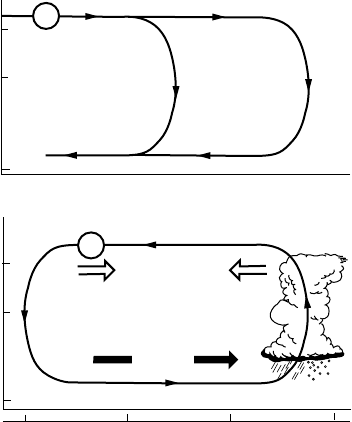
January 27, 2004 13:25 Elsevier/AID aid
348 10 the general circulation
Lower
sea-level pressure
Weak surface winds
cold
Higher
sea-level pressure
300
500
1000
J
(a)
300
500
1000
(b)
Strong eddy
heat flux
Subtropical
highs
Strong westerly surface winds
Oceanic
lows
30¡ 40¡ 50¡
60¡
Latitude
Strong convergence
of eddy flux of
westerly momentum
J
cool
Pressure (hPa)
Fig. 10.16 Meridional cross sections showing the relationship between the time mean secondary
meridional circulation (continuous thin lines with arrows) and the jet stream (denoted
by J ) at locations (a) upstream and (b) downstream from the jet stream cores. (After
Blackmon et al., 1977. Reproduced with permission of the American Meteorological
Society.)
acceleration. This is an order of magnitude stronger than the zonal-mean indirect
cell (Ferrel cell) that prevails in midlatitudes. Downstream of the jet core, however,
the secondary circulation is thermally indirect, but much stronger than the zonally
averaged Ferrel cell. It is interesting to note that the vertical motion pattern on the
poleward (cyclonic shear) side of the jet is similar to that associated with deep
transient baroclinic eddies in the sense that subsidence occurs to the west of the
stationary trough associated with the jet, and ascent occurs east of the trough (see,
e.g., Fig. 6.12).
Because the growth rate of baroclinically unstable synoptic scale disturbances
is proportional to the strength of the basic state thermal wind, it is not surprising
that the Pacific and Atlantic jet streams are important source regions for storm
development. Typically, transient baroclinic waves develop in the jet entrance
region, grow as they are advected downstream, and decay in the jet exit region. The
role of these transient eddies in maintenance of the jetstream structure is rather
complex. Transient eddy heat fluxes, which are strong and poleward in the storm
tracks, appear to act to weaken the climatological jets. The transient eddy vorticity
January 27, 2004 13:25 Elsevier/AID aid
10.6 low-frequency variability 349
flux in the upper troposphere, however, appears to act to maintain the jet structure.
In both cases the secondary ageostrophic circulation associated with the jet tends
to partly balance the influence of the transient eddy fluxes in order to maintain the
mean thermal and momentum balances.
10.6 LOW-FREQUENCY VARIABILITY
An understanding of the general circulation requires consideration not only of
the zonal-mean and stationary wave components and their variations with the
annual cycle, but also of irregular variability on time scales longer than that of
individual transient eddies. The term low-frequency variability is generally used
to describe such components of the general circulation. The observed spectrum of
low-frequency variability ranges from weather anomalies lasting only 7–10 days
to interannual variability on the scale of several years (see Section 11.1.6).
One possible cause of atmospheric low-frequency variability is forcing due to
anomalies in sea surface temperature (SST), which themselves arise from coherent
air–sea interaction. Because of the large thermal inertia of the oceanic surface
mixed layer, such anomalies tend to have time scales much longer than those
associated with subseasonal variations in the atmosphere; they are thought to be
of greatest significance on the seasonal and interannual time scales.
It is believed, however, that substantial variability on subseasonal timescales can
arise in midlatitudes in the absence of anomalous SST forcing as a result of internal
nonlinear atmospheric dynamics, although SST anomalies may tend to favor the
occurrence of certain types of variations. One example of internally generated low-
frequency variability is the forcing of large-scale anomalies by potential vorticity
fluxes of high-frequency transient waves. This process appears to be important
in the maintenance of high-amplitude quasi-stationary wave disturbances called
blocking patterns. Some types of blocking may also be related to special nonlinear
wave patterns called solitary waves, in which damping by Rossby wave dispersion
is balanced by intensification due to nonlinear advection. Although most internal
mechanisms involve nonlinearity, there is some evidence that the longitudinally
dependent time-mean flow may be unstable to linear barotropic normal modes that
are stationary in space, but oscillate in time at low frequencies. Such modes, which
are global in scale, may be responsible for some observed teleconnection patterns.
10.6.1 Climate Regimes
It has long been observed that extratropical circulation appears to alternate between
a so-called high-index state, corresponding to a circulation with strong zonal flow
and weak waves, and a “low-index” state with weak zonal flow and high-amplitude
waves. This behavior suggests that more than one climate regime exists consistent
with a given external forcing and that the observed climate may switch back and

January 27, 2004 13:25 Elsevier/AID aid
350 10 the general circulation
forth between regimes in a chaotic fashion. Whether the high-index and low-index
states actually correspond to distinct quasi-stable atmospheric climate regimes
is a matter of controversy. The general notion of vacillation between two quasi-
stable flow regimescan, however, be demonstrated quite convincinglyin laboratory
experiments. Such experiments are described briefly in Section 10.7.
The concept of climate regimes can also be demonstrated in a highly simpli-
fied model of the atmosphere developed by Charney and DeVore (1979). They
examined the equilibrium mean states that can result when a damped topographic
Rossby wave interacts with the zonal-mean flow. Their model is an extension
of the topographic Rossby wave analysis given in Section 7.7.2. In this model
the wave disturbance is governed by (7.99), which is the linearized form of the
barotropic vorticity equation (7.94) with weak damping added. The zonal-mean
flow is governed by the barotropic momentum equation
∂
u
∂t
=−D
(
u
)
− κ
(
u − U
e
)
(10.71)
where the first term on the right designates forcing by interaction between the waves
and the mean flow, and the second term represents a linear relaxation toward an
externally determined basic state flow, U
e
.
The zonal mean equation (10.71) can be obtained from (7.94) by dividing the
flow into zonal mean and eddy parts and taking the zonal average to get
∂
∂t
−
∂
u
∂y
=−
∂
∂y
v
g
ζ
g
−
f
0
H
∂
∂y
v
g
h
T
which after integrating in y and adding the external forcing term yields (10.71) with
D
(
u
)
=−v
g
ζ
g
−
f
0
H
v
g
h
T
(10.72)
As shown in Problem 10.5, the eddy vorticity flux [the first term on the right in
(10.72)] is proportional to the divergence of the eddy momentum flux. The second
term, which is sometimes referred to as the form drag, is the equivalent in the
barotropic model of the surface pressure torque term in the angular momentum
balance equation (10.43).
If h
T
and the eddy geostrophic streamfunction are assumed to consist of single
harmonic wave components in x and y, as given by (7.96) and (7.97), respec-
tively, the vorticity flux vanishes, and with the aid of (7.100) the form drag can be
expressed as
D
(
u
)
=−
f
0
H
v
g
h
T
=
rK
2
f
2
0
2uH
2
h
2
0
cos
2
ly
K
2
− K
2
s
2
+ ε
2
(10.73)
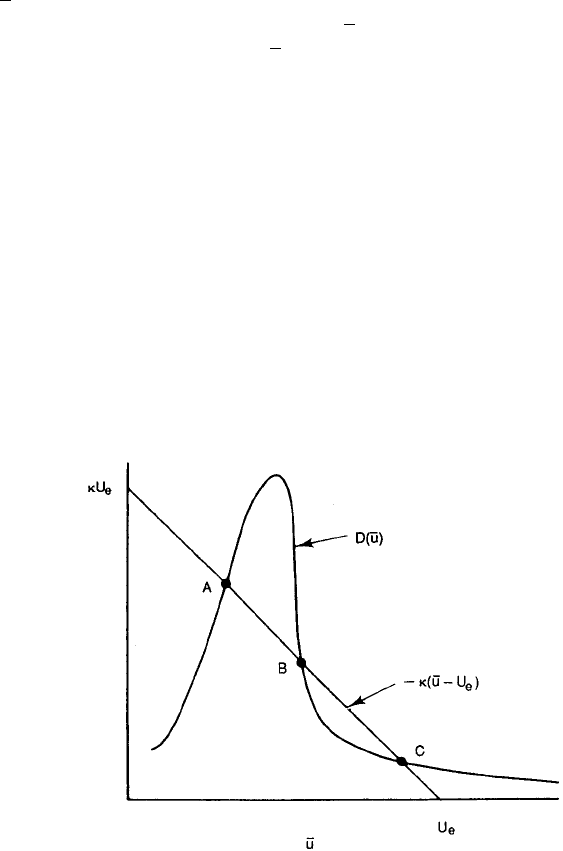
January 27, 2004 13:25 Elsevier/AID aid
10.6 low-frequency variability 351
where r is the spin-down rate due to boundary layer dissipation, ε is as defined
below (7.100), and K
s
is the resonant stationary Rossby wave number defined
in (7.93).
It is clear from (10.73) that the form drag will have a strong maximum when
u = β
K
2
, as shown schematically in Fig. 10.17. The last term on the right in
(10.71), however, will decrease linearly as
u increases. Thus, for suitable param-
eters there will be three values of
u (labeled A, B, and C in Fig. 10.17) for which
the wave drag just balances the external forcing so that steady-state solutions may
exist. By perturbing the solution about the points A, B, and C, it is shown easily
(Problem 10.12) that point B corresponds to an unstable equilibrium, whereas the
equilibria at points A and C are stable. Solution A corresponds to a low-index
equilibrium, with high-amplitude waves analogous to a blocking regime. Solution
C corresponds to a high-index equilibrium with strong zonal flow and weak waves.
Thus, for this very simple model there are two possible “climates” associated with
the same forcing.
The Charney–DeVore model is a highly oversimplified model of the atmosphere.
Models that contain more degrees of freedom do not generally have multiple steady
solutions. Rather, there is a tendency for the (unsteady) solutions to cluster about
certain climate regimes and to shift between regimes in an unpredictable fashion.
Such behavior is characteristic of a wide range of nonlinear dynamical systems
and is popularly known as chaos (see Section 13.8).
Fig. 10.17 Schematic graphical solution for steady-state solutions of the Charney–DeVore model.
(Adapted from Held, 1983.)
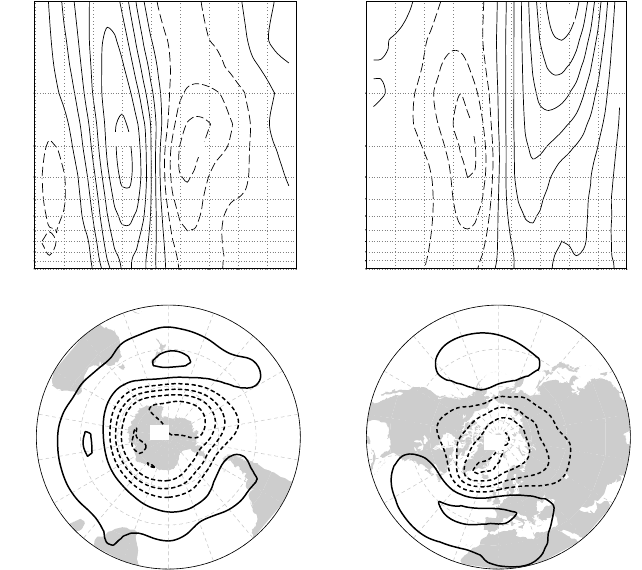
January 27, 2004 13:25 Elsevier/AID aid
352 10 the general circulation
10.6.2 Annular Modes
If a second meridional mode is added to the Charney–DeVore model (see MAT-
LAB exercise M10.2), oscillatory solutions can be obtained that bear a qualita-
tive resemblance to the observed leading modes of variability in the extratropical
atmospheric circulation in both hemispheres. These observed modes, referred to as
annular modes, are characterized by geopotential anomalies of opposite signs in the
polar and midlatitude regions and corresponding mean zonal wind anomalies with
opposite signs equatorward and poleward of about 45
◦
latitude (Fig. 10.18). The
-35
Z
1000
-40
Z
850
SH NH
3.5
-1.5
-1.5
3.0
Regressions on the annular modes
100
500
1000
300
100
500
1000
300
EQ 30N 60N 90NEQ30S60S90S
(a)
(b)
(c)
(d)
Fig. 10.18 (Top) Latitude–height cross sections showing typical amplitudes of annular mode anoma-
lies for mean-zonal wind (ordinate labels are pressure in hPa, contour interval 0.5ms
−1
).
(Bottom) Lower tropospheric geopotential height (contour interval 10 m). (Left) Southern
Hemisphere; (right) Northern Hemisphere. Phase shown corresponds to the high index
state (strong polar vortices). The low index state would have opposite signed anomalies.
(After Thompson and Wallace, 2000.)
January 27, 2004 13:25 Elsevier/AID aid
10.6 low-frequency variability 353
annular modes exist year round in the troposphere, but are strongest in the winter
when they extend well into the stratosphere, especially in the Northern Hemi-
sphere. The zonally symmetric mean-flow anomalies associated with the annular
modes are apparently maintained by anomalous eddy momentum fluxes, which are
themselves influenced by the zonally symmetric flow anomalies. Because these
modes have their greatest influence at high latitudes, the northern and southern
annular modes are sometimes referred to as the Arctic and Antarctic oscillations,
respectively; it should be stressed, however, that they are not periodic oscillations,
but rather represent two extremes of a broad distribution of climate states, with a
wide range of associated time scales.
There is some evidence for downward propagation of the wintertime annular
modes, suggesting that circulation changes in the stratosphere may precede annular
mode changes in the troposphere. Dynamical linkages between the stratosphere
and the troposphere are discussed further in Chapter 12.
10.6.3 Sea Surface Temperature Anomalies
Sea surface temperature anomalies influence the atmosphere through altering the
flux of latent and sensible heat from the ocean, and thus providing anomalous
heating patterns. The efficacy of such anomalies in exciting global scale responses
depends on their ability to generate Rossby waves.A thermal anomaly can generate
a Rossby wave response only by perturbing the vorticity field. This requires that
the thermal anomaly produces an anomalous vertical motion field, which in turn
produces anomalous vortex tube stretching.
For low-frequency disturbances the thermodynamic energy equation (10.5) may
be approximated as
V ·∇T + wN
2
HR
−1
≈ J/c
p
(10.74)
Thus, diabatic heating can be balanced by horizontal temperature advectionor by
adiabatic cooling due to vertical motion. The ability of diabatic heating produced
by a sea surface temperature anomaly to generate Rossby waves depends on which
of these processes dominates. In the extratropics SST anomalies primarily generate
low-level heating, which is balanced mainly by horizontal temperature advection.
In the tropics, positive SST anomalies are associated with enhanced convection,
and the resulting diabatic heating is balanced by adiabatic cooling.Tropical anoma-
lies have their greatest effect in the Western Pacific where the average sea surface
temperature is very high so that even a small positive anomaly can generate large
increases in evaporation due to the exponential increase of saturation vapor pres-
sure with temperature. By continuity of mass the upward motion in cumulonimbus
convection requires convergence at low levels and divergence in the upper tropo-
sphere. The low-level convergence acts to sustain the convection by moistening
and destabilizing the environment, whereas the upper-level divergence generates
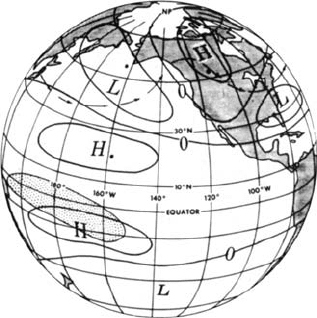
January 27, 2004 13:25 Elsevier/AID aid
354 10 the general circulation
Fig. 10.19 The Pacific North American (PNA) pattern of middle and upper tropospheric height
anomalies for Northern Hemisphere winter during an ENSO event in the tropical Pacific.
The region of enhanced tropical precipitation is shown by shading. Arrows depict a
500-hPa streamline for the anomaly conditions. H and L designate anomaly highs and
lows, respectively. The anomaly pattern propagates along a great circle path with an east-
ward component of group velocity, as predicted by stationary Rossby wave theory. (After
Horel and Wallace, 1981. Reproduced with permission of the American Meteorological
Society.)
a vorticity anomaly. If the mean flow is westerly in the region of upper level diver-
gence, the forced vorticity anomaly will form a stationary Rossby wave train. The
observed upper tropospheric height anomalies during the Northern Hemisphere
winter associated with such an anomaly [referred to as the Pacific North Amer-
ica Pattern (PNA)] are shown schematically in Fig. 10.19. The pattern strongly
suggests a train of stationary Rossby waves that emanates from the equatorial
source region and follows a great circle path, as predicted by barotropic Rossby
wave theory (Section 10.5.1). In this manner, tropical SST anomalies may gen-
erate low-frequency variability in the extratropics. It is possible that the effects
of SST anomalies and of internal variability are not completely independent. In
particular, it is more likely that the atmosphere will tend to preferentially reside
in those regimes whose anomalous flow is correlated with the pattern in Fig 10.19
than would be the case in the absence of SST anomalies.
10.7 LABORATORY SIMULATION OFTHEGENERALCIRCULATION
We have shown that the gross features of the general circulation outside the tropics
can be understood within the framework of the quasi-geostrophic system; the
observed zonal-mean circulation and the atmospheric energy cycle are both rather
January 27, 2004 13:25 Elsevier/AID aid
10.7 laboratory simulation of the general circulation 355
well described by quasi-geostrophic theory. The fact that the quasi-geostrophic
model, in which the spherical earth is replaced by the β plane, can successfully
model many of the essential features of the general circulation suggests that the
fundamental properties of the general circulation are not dependent on parameters
unique to a spherical planet, butmay be common to all rotating differentially heated
fluids. That the conjecture is in fact correct can be demonstrated in the laboratory
with a rather simple apparatus.
In one group of experiments the apparatus consists of a cylindrical vessel that is
rotated about its vertical axis. The vessel is heated at its rim and cooled at its center.
These experiments are often referred to as dishpan experiments, as some of the
first experiments of this type utilized an ordinary dishpan. The fluid in the dishpan
experiments crudely represents one hemisphere in the atmosphere, with the rim
of the dishpan corresponding to the equator and the center to the pole. Because
the geometry is cylindrical rather than spherical, the β effect is not modeled for
baroclinic motions in this type of system.
3
Thus the dishpan experiments omit
dynamical effects of the atmospheric meridional vorticity gradient as well as the
geometrical curvature terms, which were neglected in the quasi-geostrophic model.
For certain combinations of rotation and heating rates, the flow in the dishpan
appears to be axially symmetric with a steady azimuthal flow that is in thermal
wind equilibrium with the radial temperature gradient, and a superposed direct
meridional circulation with rising motion near the rim and sinking near the center.
This symmetric flow is usually called the Hadley regime, as the flow is essentially
that of a Hadley cell.
For other combinations of rotation and heating rates, however, the observed
flow is not symmetric. It consists, rather, of irregular wave-like fluctuations and
meandering zonal jets. In such experiments, velocity tracers on the surface of the
fluid reveal patterns very similar to those on midlatitude upper air weather charts,
whereas tracers near the lower boundary reveal structures similar to atmospheric
fronts. This type of flow is usually called the Rossby regime, although it should be
noted that the observed waves are not Rossby waves because there is no β effect
in the tank.
Experiments have also been carried out using an apparatus in which the fluid is
contained in the annular region between two coaxial cylinders of different radii.
In these annulus experiments, the walls of the inner and outer cylinders are held at
constant temperatures so that a precisely controlled temperature difference can be
maintained across the annular region. Very regular wave patterns can be obtained
for certain combinations of rotation and heating. In some cases the wave patterns
are steady, whereas in other cases they undergo regular periodic fluctuations called
vacillation cycles (see Fig. 10.20). As mentioned in the last section, vacillation
3
For barotropic motions the radial height gradient of the rotating fluid in the cylinder creates an
“equivalent” β effect (see Section 4.3).
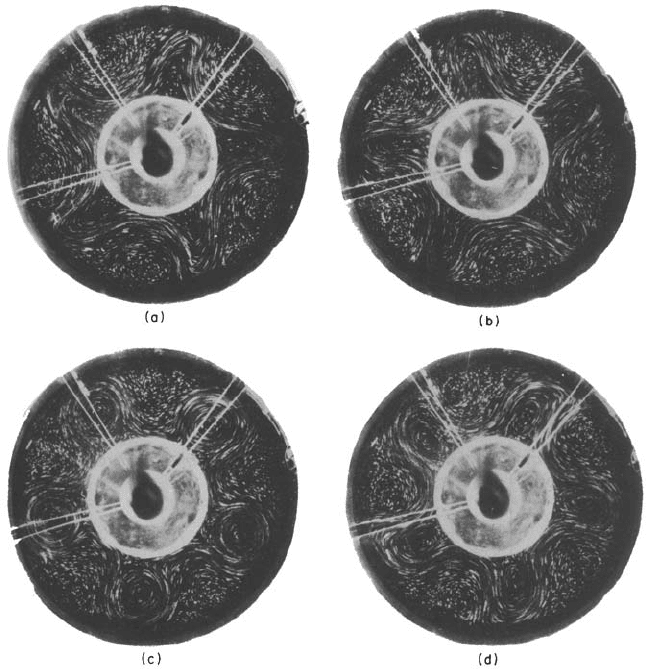
January 27, 2004 13:25 Elsevier/AID aid
356 10 the general circulation
Fig. 10.20 Time exposures showing the motion of surface tracer particles in a rotating annulus. The
four photographs illustrate various stages of a five-wave-tilted trough vacillation cycle.
The period of the vacillationcycle is 16.25 revolutions, and the photographs are at intervals
of four revolutions. (Photographs by Dave Fultz.)
is an example of internally generated low-frequency variability, which may be
analogous to some atmospheric climate variability.
In order to determine whether the annulus experiments are really valid ana-
logues of the atmospheric circulation or merely bear an accidental resemblance to
atmospheric flow, it is necessary to analyze the experiments quantitatively. Math-
ematical analysis of the experiments can proceed from essentially the same equa-
tions that are applied to the atmosphere, except that cylindrical geometry replaces
spherical geometry and temperature replaces potential temperature in the heat
equation. (Because water is nearly incompressible, adiabatic temperature changes

January 27, 2004 13:25 Elsevier/AID aid
10.7 laboratory simulation of the general circulation 357
are negligible following the motion.) In addition, the equation of state must be
replaced by an appropriate measure of the relationship between temperature and
density:
ρ = ρ
0
[
1 − ε
(
T − T
0
)
]
(10.75)
where ε is the thermal expansion coefficient (ε ≈ 2 ×10
−4
K
−1
for water) and ρ
0
is the density at the mean temperature T
0
.
Chapter 1 indicated that the character of the motion in a fluid is crucially depen-
dent on the characteristic scales of parameters such as velocity, pressure perturba-
tion, length, and time. In the laboratory the scales of these parameters are generally
many orders of magnitude different from their scales in nature. It is still possible,
however, to produce quasi-geostrophic motions in the laboratory provided that
the motions are slow enough so that the flow is approximately hydrostatic and
geostrophic. As shown in Section 2.4.2, the geostrophy of a flow does not depend
on the absolute value of the scaling parameters, but rather on a nondimensional
ratio of these parameters called the Rossby number. For annulus experiments,
the maximum horizontal scale is set by the dimensions of the tank so that it is
convenient to define the Rossby number as
Ro ≡ U/
[
(
b − a
)
]
where is the angular velocity of the tank, U is a typical relative velocity of the
fluid, and b − a is the difference between the radius b of the outer wall and the
radius a of the inner wall of the annular region.
Using the hydrostatic approximation
∂p
∂z =−ρg
together with the geostrophic relationship
2V
g
= ρ
−1
0
k × ∇p
and the equation of state (10.75) we can obtain a thermal wind relationship in
the form
∂V
g
∂z
=
εg
2
k × ∇T (10.76)
Letting U denote the scale of the geostrophic velocity, H the mean depth of fluid,
and δT the radial temperature difference across the width of the annulus, we obtain
from (10.76)
U ∼ εgH δT
/
[
2
(
b − a
)
]
(10.77)
Substituting the value of U in (10.77) into the formula for the Rossby number
yields the thermal Rossby number
Ro
T
≡ εgH δT
2
2
(
b − a
)
2
